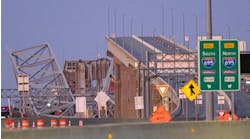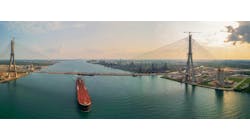By Kathryn Burke, Contributing Author
Construction of the Bear Mountain Bridge in New York began 100 years ago. Built by names like Terry & Tench, Co., and John A. Roebling’s Sons, Co., this iconic structure will celebrate its centennial anniversary because of consistent, timely maintenance and care given by the New York State Bridge Authority (NYSBA).
When construction on the Bear Mountain Bridge began in 1923, Americans were embracing their newfound mobility, thanks to the automobile. The Model T accounted for 57% of the world’s car production, and it would soon cost $250, which meant more Americans could buy it and flock to open spaces, such Bear Mountain Park, located 45 miles north of Manhattan.
Back then, Bear Mountain Park, located in the Hudson Highlands, was only accessible by boat for anyone living on the east side of the Hudson River. No vehicular crossing of the Hudson yet existed south of Albany.
As Bear Mountain Park became more popular, people waited long periods of time to gain access to boats that would get them across the river.
Terry & Tench, Co. had recently completed a suspension bridge across Rondout Creek in Kingston, N.Y., and had come south with bridge plans designed by Howard C. Baird, to build a bridge across the Hudson River at Bear Mountain. They submitted their plans to the Harriman family and Roland Harriman began to assemble investors to create the Bear Mountain Hudson River Bridge Company (BMHRB Co.).
Construction on the Bear Mountain Bridge (BMB) began on March 24, 1923.
The project required an approach road to be carved out of the south side of Anthony’s Nose, the mountain at the east side of the proposed bridge that would connect the bridge to Peekskill and points further south.
The construction of the roadway had to be done carefully so as not to obstruct rail traffic on the nearly 5,000 feet of rail lines along the river some 400 feet below the new roadway.
John Mansfield Belknap, resident engineer for the Terry & Tench Co., wrote an article in Engineering News-Record in November 1924 detailing the construction of the east approach road to the BMB.
According to Belknap, it was required to side-hill cut and then fill the mostly granite ledges and boulders with over 70% of the removed material having to be drilled and blasted. Telephone connections were established from the site of the work to the conductor’s tower near the tunnel at Anthony’s Nose.
Permission to fire each blast had to be obtained from the railroad engineers. No blasting was permitted during heavy traffic in the mornings and afternoons. The amount of blasting powder along with the number of holes that could be fired at one time were regulated by railroad engineers, often creating delays in the construction.
All that caution paid off in that there were only two times rail traffic had to be interrupted, both occurring in April 1924, when it became necessary to remove ledges of rock and rubble from below the roadway that had become loose due to blasting above.
Numerous slopes were so steep and dangerous it was necessary to use safety ropes on the men and on their instruments. A misstep could mean a 100–200-foot plunge. Many areas above and below the roadway had to be reinforced with rubble or masonry retaining walls, to prevent collapse onto or below the roadway.
The number of laborers employed to construct the roadway varied from 250 in 1923 to 650 in 1924. Because there was limited access to the roadway, inclined railroads and cableways were laid on the slopes to haul materials to the site and take away the rubble.
The roadway was completed in time for the bridge opening day. John Belknap, a Peekskill resident, was the first person to drive a car across the BMB prior to its opening.
Construction on the bridge began with digging the anchorage pits for the main cables on the east and west sides of the bridge. The entire east tower and most of the west tower would stand on the shore.
As the anchor pits were dug and the towers were erected for the BMB, the spinning of the cables began after the footbridge cable was hung.
Roebling wire cables were chosen for the BMB with Washington Roebling coming out of retirement to oversee the project. The John A. Roebling’s Sons Company’s study, “Construction of Parallel Wire Cables for Suspension Bridges,” detailed the latest design for suspension bridge cables and paved the way for a boom in bridge building.
The main span of the BMB crossed the river suspended from two main cables. The outer spans of the bridge have unloaded backstays, where no suspenders were needed, as they are supported by the truss under the roadway. Once the main cables are strung, the suspender ropes were dropped from the main cable to support the stringers that would hold up the deck. Truss structures were constructed as part of the deck to stabilize the bridge.
The Bear Mountain Bridge was the first vehicular crossing of the Hudson River south of Albany, followed by the opening of the Mid-Hudson Bridge in 1930 and the George Washington Bridge in 1932. The BMB was the longest suspended span in the world when it opened, with a main span of 1,632 feet. It was the first bridge to be built with a concrete deck. The advertisement for Bermudez Road Asphalt specifies that the BMB was a Bermudez Asphaltic Concrete Highway.
The bridge opened to the public on Thanksgiving Day in 1924. The formal ceremonies included a ribbon cutting on November 26, 1924, the day before the public could travel on the bridge.
The official procession of cars began in Peekskill, led by the West Point band, stopping at the east side of the bridge to cut a ribbon. It continued across the bridge where Mary Harriman, the matriarch of the Harriman family, removed the banner from the plaque on the unfinished toll house to officially open the Bear Mountain Bridge. The toll house would not be completed until the spring of 1925. The bridge manager lived in the west toll house with the assistant manager and his family living in the east toll house.
The Bear Mountain Hudson River Bridge Company was a private enterprise. Tolls were set to earn money for the company. When the bridge opened in 1924, the toll for a car and the driver was 80 cents, with 10 cents each for additional passengers.
When the Bridge Authority assumed responsibility for BMB in September of 1940, the first thing they did was lower the toll to 50 cents each way, as, by law, all Bridge Authority bridges must have the same toll. After World War II, the toll was lowered to 35 cents, then to 25 cents each way. Bridge Authority tolls have always been some of the lowest in the nation for long span bridges.
In 1978, the toll was collected going eastbound only. Tolls today are lower essentially than they were in 1924, when accounting for inflation.
A provision to turn the bridge over to New York after a period of 30 years was written into the original charter for BMB. For the 16 years that the BMHRB Co., operated the bridge, it only cleared a profit thrice. So, after considerable campaigning by Robert Moses, the Bridge Authority purchased the Bear Mountain Bridge for $2,275,000 in September 1940. Ceremonies took place at the Bear Mountain Inn with a special ribbon cutting on the bridge and the ceremonial meeting of the mayors of Newburgh and Peekskill, the cities connected by the Bear Mountain Bridge.
the We celebrate the history and construction of this iconic structure but recognize foremost that the maintenance of this 100-year-old structure, utilizing sound practices and employing fiscal responsibility, should be a model for caring for infrastructure everywhere.
William Moreau, former NYSBA chief engineer, recognized early on that maintaining suspension bridges required special knowledge. He organized the first suspension bridge conference at the Mid-Hudson Bridge, in 1991, bringing together suspension bridge operators from around the world to Poughkeepsie, N.Y.
For the BMB, preventative maintenance involves a crew washing the bridge every spring from the top of the roadway deck down to the bottom of the superstructure. This washes the sand, salt, and debris accumulations from the prior year off the bridge to help lessen the potential for corrosion.
Twice a year, the bearings on the bridge are greased to facilitate the thermal expansion of the bridge spans. The maintenance crews annually clean and paint portions of the bridge, and perform minor structural repairs, as required.
The Bridge Authority maintains 5- and 20-year capital plans on all its bridges, a proactive approach to schedule anticipated maintenance which is beyond the scope of the maintenance crews who handle all day-to-day and annual upkeep on the bridges. Outside contractors are required to complete capital projects.
In a time in which we recognize our seriously deficient infrastructure in the U.S., NYSBA’s mantra, “Maintenance deferred is maintenance denied,” has enabled the BMB to enter its next 100 years in good condition. NYSBA has long-range plans to continue to maintain BMB well into the future. This should be celebrated and modeled in the transportation industry.
Not many things survive, and rarely ever thrive, for 100 years. The Bear Mountain Bridge is a uniquely iconic piece of New York infrastructure that has not only survived, but remains in great condition thanks to its maintenance. R&B
Kathryn Burke [TK]



